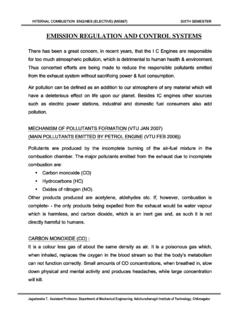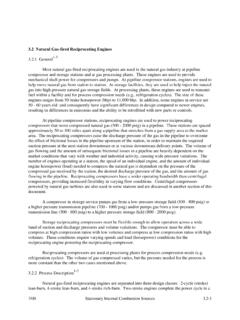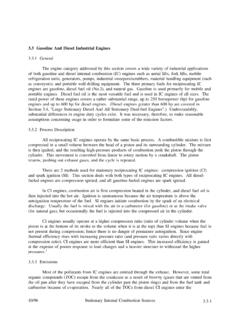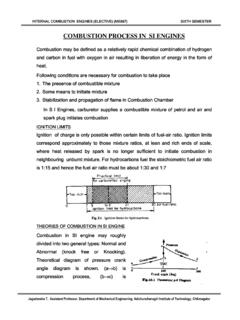Transcription of Environmental Effects of Battery Electric and Internal ...
1 Environmental Effects of Battery Electric and Internal combustion Engine Vehicles June 16, 2020 Congressional Research Service R46420 Congressional Research Service SUMMARY Environmental Effects of Battery Electric and Internal combustion Engine Vehicles Increased deployment of Battery Electric vehicles (BEVs) and other alternative-fueled vehicles in the United States could have a variety of Effects on energy security, the economy, and the environment. In an effort to address certain Environmental concerns, including climate change, some Members of Congress and some stakeholder interest groups have expressed interest in the promotion of these technologies specifically BEV technologies.
2 This interest may include an analysis of the Environmental Effects of BEVs from a systems perspective, commonly referred to as life cycle assessment (LCA). Practitioners of LCAs strive to be comprehensive in their analyses, and the Environmental Effects modeled by many rely on a set of boundaries referred to as cradle-to-grave. Cradle-to-grave assessments in the transportation sector model the Environmental Effects associated with the complete life cycle of a vehicle and its fuel. This consists of the vehicle s raw material acquisition and processing, production, use, and end-of-life options, and the fuel s acquisition, processing, transmission, and use.
3 LCA practitioners focus on a variety of potential Environmental Effects , including global warming potential, air pollution potential, human health and ecosystem Effects , and resource consumption. Literature analyzing the life cycle Environmental Effects of BEV technology both in isolation and in comparison to Internal combustion engine vehicle (ICEV) technology is extensive and growing. However, as the literature grows, so does the range of results. The divergence is due to the differing system parameters of each study, including the selected goals, scopes, models, scales, time horizons, and datasets.
4 While each study may be internally consistent based upon the assumptions within it, analysis across studies is difficult. Because of these complexities and divergences, CRS sees significant challenges to quantifying a life cycle assessment of BEV and ICEV technologies that incorporates all of the findings in the published literature. A review of the literature, however, can speak broadly to some of the trends in the life cycle Environmental Effects as well as the relative importance of certain modeling selections. Broadly speaking, a review of the literature shows that in most cases BEVs have lower life cycle greenhouse gas (GHG) emissions than ICEVs.
5 In general, GHG emissions associated with the raw materials acquisition and processing and the vehicle production stages of BEVs are higher than for ICEVs, but this is typically more than offset by lower vehicle in-use stage emissions, depending on the electricity generation source used to charge the vehicle batteries. The importance of the electricity generation source used to charge the vehicle batteries is not to be understated: one study found that the carbon intensity of the electricity generation mix could explain 70% of the variability in life cycle results. In addition to lower GHG emissions, many studies found BEVs offer greater local air quality benefits than ICEVs, due to the absence of vehicle exhaust emissions.
6 However, both BEVs and ICEVs are responsible for air pollutant emissions during the upstream production stages, including emissions during both vehicle and fuel production. Further, BEVs may be responsible for greater human toxicity and ecosystems Effects than their ICEV equivalents, due to (1) the mining and processing of metals to produce batteries, and (2) the potential mining and combustion of coal to produce electricity. These results are global Effects , based on the system boundaries and input assumptions of the respective studies. In addition to a review of the literature, CRS focused on the results of one study in order to present an internally consistent example of an LCA.
7 This specific study finds that the life cycle of selected lithium-ion BEVs emits, on average, an estimated 33% less GHGs, 61% less volatile organic compounds, 93% less carbon monoxide, 28% less nitrogen oxides, and 32% less black carbon than the life cycle of ICEVs in the United States. However, the life cycle of the selected lithium-ion BEVs emits, on average, an estimated 15% more fine particulate matter and 273% more sulfur oxides, largely due to Battery production and the electricity generation source used to charge the vehicle batteries. Further, the life cycle of the selected lithium-ion BEVs consumes, on average, an estimated 29% less total energy resources and 37% less fossil fuel resources, but 56% more water resources.
8 These results are global Effects , based on the system boundaries and input assumptions of the study. R46420 June 16, 2020 Richard K. Lattanzio Specialist in Environmental Policy Corrie E. Clark Analyst in Energy Policy Environmental Effects of Battery Electric and Internal combustion Engine Vehicles Congressional Research Service Contents Introduction .. 1 Life Cycle Assessment .. 2 Life Cycle Stages .. 5 A. Raw Material Extraction and Processing .. 5 Factors Affecting the Raw Material Stage .. 6 Environmental Assessment of Selected Materials for the Car Body for ICEVs and BEVs.
9 6 Environmental Assessment of Selected Materials Specific to BEVs .. 7 B. Vehicle and Battery Production .. 10 Factors Affecting the BEV Production Stage .. 11 Environmental Assessment of Battery Manufacturing .. 11 C. Vehicle In-Use (Including the Fuel Life Cycle) .. 13 Factors Affecting the ICEV In-Use Stage .. 14 Environmental Assessment of ICEV In-Use .. 15 Factors Affecting the BEV In-Use Stage .. 16 Environmental Assessment of BEVs In-Use .. 19 D. Vehicle End-of-Life .. 20 Factors Affecting the End-of-Life Stage .. 20 Environmental Assessment of End-of-Life Management.
10 20 Environmental Assessment of Battery Recycling .. 21 A Discussion of the Published LCA Literature .. 23 Review of the Findings from Selected LCAs .. 23 Review of the Findings from Dunn et al., 2015 (Updated in 2019) .. 24 Dunn et al., 2015 (Updated) Modeling Assumptions .. 24 Selected Environmental Effects Categories .. 25 Issues for Consideration .. 31 Summary of Findings .. 31 Considerations Affecting Life Cycle Performance .. 32 Issues Regarding LCA and Policy Development .. 33 Figures Figure 1. Simplified Illustration of the Complete Life Cycle of Vehicles and Fuels.

















